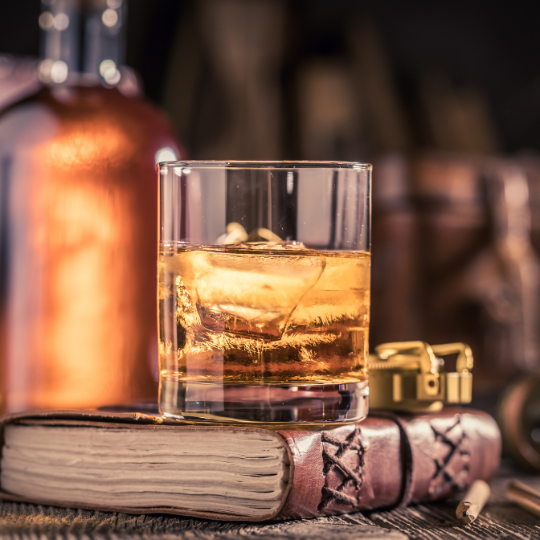
From Novice to Whiskey Expert: A Beginner's Journey with Whiskey
Share

Are you new to the world of whiskey and eager to embark on a journey to become a whiskey expert? Look no further! In this beginner's guide, we will take you through the ins and outs of whiskey, from how to choose the right bottle to the best ways to savor and enjoy this exquisite spirit. Whether you're a man or a woman, a whiskey enthusiast or a curious novice, this guide is designed to provide you with the knowledge and confidence you need to navigate the world of whiskey with ease. Join us as we explore different types of whiskey, the process of distilling, and even embark on a virtual tour of the famous Bourbon Trail. Get ready to enhance your appreciation and understanding of whiskey, as we take you on a journey from novice to whiskey expert. Let the adventure begin!
Starting Your Whiskey Journey
A Novice’s First Steps
Getting started with whiskey can seem intimidating, but it doesn't have to be. The
first step to becoming a whiskey expert is developing a curiosity and appreciation for this distinctive spirit. Start by familiarizing yourself with the basics. Learn about the different types of whiskey—such as bourbon, rye, and scotch—and understand what makes each one unique. Each type of whiskey has distinct flavors and characteristics, influenced by factors like the grains used in its production, the distillation process, and the aging method.
Next, try a variety of whiskeys to discover what you like. Start with the more approachable varieties, those that are smoother and less complex, and gradually move towards the heavier, more flavorful ones. Remember, it's not about finding the most expensive bottle—it's about discovering what suits your taste.
Lastly, remember to take it slow. Savor each sip and take the
time to identify the different flavors and aromas. Whiskey tasting is not just about the drink itself, but about the experience and the journey. It's about immersing yourself in the culture, history, and craftsmanship behind each bottle. So take your first step and embark on your whiskey journey today.
Tracing the Origins of Whiskey
Whiskey's origins are deeply rooted in history, with its creation traced back to ancient civilizations. The art of distilling, the process by which whiskey is made, was initially developed by the ancient Babylonians and Egyptians. However, it was the Celtic and Gaelic cultures that refined this process to produce what we now know as whiskey.
The word 'whiskey' itself comes from the Gaelic phrase 'uisce beatha', meaning 'water of life', highlighting the importance of this spirit in early societies. Whiskey production grew in popularity across Ireland and Scotland, with monks in medieval times using distillation for medicinal purposes.
As societies evolved, so did the production of whiskey. The 18th century saw the introduction of continuous stills, significantly increasing the efficiency and scale of whiskey production. This was a game-changer, leading to the bustling whiskey industry we know today.
Understanding whiskey's origins helps us appreciate not just the spirit, but also the heritage and tradition encapsulated in every bottle. From its humble beginnings to its current global status, the journey of whiskey mirrors that of humanity, blending ancient practices with modern innovation to create a timeless and beloved drink.

Understanding Whiskey Categories and Styles
Bourbon, Rye, and More: Discerning Between Types
In the world of whiskey, there are numerous types and styles, each with its own unique characteristics. Two of the most popular types are bourbon and rye.
Bourbon, named after Bourbon County in Kentucky, is a type of American whiskey that is primarily made from corn and aged in new charred oak barrels. It's known for its rich, full-bodied flavor with sweet notes of vanilla, caramel, and oak.
Rye, on the other hand, can be either American or Canadian. American rye must be made from at least 51% rye grain and aged in new charred oak barrels, resulting in a bold, spicy flavor. Canadian rye, however, doesn't have strict regulations on the rye content and often has a smoother, lighter flavor.
Other types of whiskey include Scotch, which is made in Scotland and often has a smoky flavor due to the use of peat in the malting process, and Irish whiskey, which is typically triple distilled for a smoother taste.
The key to discerning between these types is to try them. Take note of the flavors, aromas, and the overall experience of each. Remember, there are no right or wrong choices—only personal preference.
Exploring Scotland's Distilleries

Scotland is renowned worldwide for its exceptional whiskey production, with its distilleries being an integral part of the country's heritage and culture. Each distillery in Scotland has its own unique methods of production, giving their whiskey a distinctive flavor profile that can't be replicated anywhere else.
The country is split into several whiskey-producing regions, each known for their specific style. The Highlands, for instance, is known for its full-bodied, slightly peaty whiskeys with notes of heather and spice. The Lowlands offers lighter, smoother whiskeys perfect for beginners, while the island of Islay is famous for its heavily peated, smoky whiskeys.
Visiting these distilleries offers a chance to delve deeper into the whiskey-making process. From the malting of the barley to the distillation in copper stills and the aging in oak barrels, you can witness first-hand the craftsmanship and dedication that goes into each bottle.
Exploring Scotland's distilleries is more than just a whiskey tasting experience—it's a journey through Scotland's history, landscapes, and people. It's an adventure that every whiskey lover should embark on, providing an invaluable understanding of the spirit's heritage and complexity.
Buying Whiskey: A Handy Guide
Where to Buy: The Importance of Choosing the Right Store
When it comes to buying whiskey, the place of purchase plays a crucial role in ensuring you get a quality bottle. The right store can provide a variety of options, offer helpful recommendations, and ensure proper storage of the whiskey.
Specialty liquor stores or whiskey shops are typically the best places to buy whiskey. These stores often have a wider selection, including unique or limited-edition bottles that you may not find in regular liquor or grocery stores. The staff in these stores are usually knowledgeable about whiskey and can provide valuable advice tailored to your preferences and budget.
Online shopping is another viable option, offering convenience and access to an even broader range of products. However, make sure to purchase from reputable online retailers to ensure the authenticity and quality of the whiskey.
Lastly, consider the storage conditions. Whiskey should be stored upright, away from direct sunlight, and at a stable temperature to preserve its quality. A good store will take these factors into account in their storage, ensuring that the whiskey you buy is in optimal condition.
Remember, buying whiskey is not just a transaction—it's part of the overall whiskey experience. Choosing the right store can enhance this experience, helping you explore and appreciate the world of whiskey even more.
Decoding Labels: What to Look for When Buying Whiskey
Understanding the information on a whiskey label can be key to making a good purchase. It's not just about the brand or the price; the label contains valuable details about the whiskey's characteristics and quality.
Firstly, look for the type of whiskey. This could be bourbon, rye, scotch, or a different style, each with its own distinct flavors and production methods.
Next, check the age statement. This indicates how long the whiskey was aged in barrels. Generally, the longer the aging period, the more complex and smooth the flavors. However, this doesn't mean older is always better. Depending on your preference, a younger whiskey might suit your taste.
The alcohol by volume (ABV) or proof is another important detail. A higher ABV or proof often means a more intense flavor and warmth.
Lastly, words like 'single malt', 'blended', 'cask strength', or 'single barrel' provide additional information about the production process and can give clues about the whiskey's flavor profile.
Decoding the label isn't about being a whiskey snob—it's about understanding what you're buying and finding the whiskey that suits your taste. After all, whiskey is about enjoyment, and knowing what's in the bottle is the first step to a great whiskey experience.
Appreciating Whiskey: The Art of Tasting
Whiskey Tasting Tips for Beginners
For those new to the world of whiskey, tasting can seem like a daunting task. But fear not, with a few simple tips, you can start appreciating this sophisticated spirit like a pro.
First, observe the color. This can give you clues about the whiskey's age and the type of barrel it was aged in. Darker shades typically indicate a longer aging period.
Next, take a good sniff. A large part of tasting is in the smell. Swirl the whiskey gently in the glass to release its aromas. Take a moment to identify different scents—this could range from fruity and floral notes to hints of spice or smoke.
When you take a sip, let the whiskey roll over your tongue before swallowing to allow all your taste buds to engage with the different flavors. Try to identify the initial taste (the 'attack'), the middle taste (the 'body'), and the aftertaste (the 'finish').
Finally, remember that tasting whiskey is a personal experience. There are no wrong impressions or tastes. What matters is your enjoyment. So take your time, savor each sip, and most importantly, enjoy the journey!
Engaging the Senses: How to Enjoy Whiskey to the Fullest
Enjoying whiskey isn't just about the taste—it's an experience that involves all the senses. Here's how you can engage each one to enjoy whiskey to the fullest.
First, look at the color. The hue can tell you about the whiskey's age and cask type. A deeper color usually indicates a longer aging period or a sherry cask, while a lighter color suggests a younger whiskey or bourbon cask aging.
Next, engage your sense of smell. A significant portion of taste comes from smell, so take a moment to appreciate the aroma before you sip. You might pick up notes of caramel, oak, fruit, or spices.
When it comes to taste, don't rush. Let the whiskey linger on your palate to pick up the various flavor notes. Is it sweet, spicy, or smoky? Is the finish long or short?
Finally, touch plays a role too. Feel the weight of the glass, the texture of the liquid, even the warmth spreading in your chest after a sip.
Remember, enjoying whiskey is a personal journey. The important thing is to take your time, explore different types, and find what you enjoy. Happy tasting!

